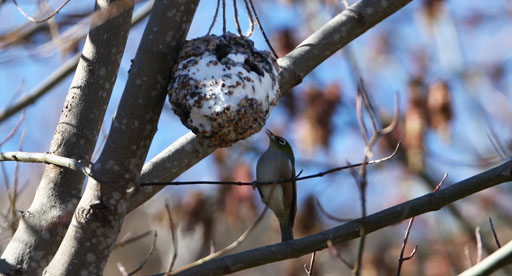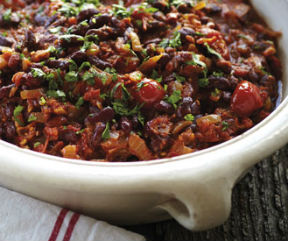
By June there’s not a lot left to eat in the garden – for us or, for that matter, for the birds. I hate to think of all those lovely bellbirds, waxeyes and tuis going hungry, so throughout winter I hang bird feeders around the garden to keep them going.
Annabel's Smoky Chilli Beans
I’ll often soak and boil a big batch of beans and freeze them, ready to throw into dishes like this. If you don’t have time to soak and cook the beans, use three 400g cans of kidney beans instead. 
- Prep time: 15 mins + soaking
- Cook time: about 2 hours
- Serves: 10 as a side
Ingredients
- 2 cups dried beans (4½-5 cups cooked beans)
- 4 dried smoked chillies (ancho)
- 2 cups boiling water
- 3 tsp cumin seeds
- 1 tsp coriander seeds
- ¼ cup olive oil
- 2 onions, coarsely chopped
- 4 cloves garlic, chopped
- 1 tbsp oregano leaves
- 1 red chilli, finely chopped
- 1.2kg tomatoes, chopped, or 3 x 400g cans chopped tomatoes or tomato pulp
- 1 tsp sugar
- 1 tsp salt
- ground black pepper
- ¼ cup chopped coriander leaves, to garnish
Method
- Place beans in a large pot, cover with cold water and leave to soak overnight.
- Drain and cover with fresh water (do not add salt).
- Bring to a boil and cook uncovered until tender (about 1-1½ hours, depending on age and dryness of beans). Drain.
- Remove stems from dried smoked chillies and discard. Cover chillies with boiling water and soak 30 minutes until tender.
- Meanwhile, toast cumin and coriander seeds in a dry pan over medium-high heat, shaking occasionally, until fragrant and starting to pop (about 1 minute). Crush in a mortar and pestle.
- Heat oil in a large pan and cook onions and garlic over a low heat until softened but not browned (about 10 minutes).
- Add crushed seeds, oregano, fresh chilli, tomatoes, sugar, salt and pepper and bring to a boil.
- Lift the smoked chillies out of their soaking liquid, reserving the liquid.
- Chop chillies finely and add to the tomato sauce with the soaking liquid and the cooked beans.
- Bring to a boil and simmer uncovered, stirring occasionally to prevent catching, until thick (about 45 minutes). Alternatively, bake for about 1½ hours in an oven preheated to 180°C.
To serve, adjust seasonings to taste then spoon into a deep serving dish and top with coriander.
Read more of Annabel's guest blogs here
I’ve been doing it for a couple of years and now the birds stay put at the end of autumn, knowing there will be a regular food supply for them throughout the winter. When it’s bleak and cold and grey outside their birdsong is uplifting.
Last winter we made seed cones for the birds for the first time – it’s such a fun thing to do with kids. You just get a few pinecones, spread peanut butter or softened coconut oil all over them and then roll them in birdseed mix and hang them in the trees. It may take a few days for the birds to discover them, but once they do it’s a feeding frenzy.
If you’re a gardener and you’re looking for ways to attract native birds, the best thing to do is plant trees and shrubs that provide them with both nectar and fruit, especially in the winter and spring when there’s not a lot of other food about. It’s a unique attribute of New Zealand native birds that many are both nectar feeders and seed and berry feeders.
No matter how small your space, any garden can be made more attractive to birds and other wildlife. Winter mulching also helps keep birds happy as it attracts insects for them to feed on.
In terms of native plants, those that best attract native birds are kowhai, kaka beak, New Zealand tree fuchsia, wineberry, karamu, five-finger and flax. If you have room, it’s a good idea to plant a couple of different varieties of each in your garden to extend the flowering season.
Kowhai is a wonderful winter-flowering tree that tuis and other native birds adore. The flowers of the species Sophora microphylla appear in winter before the other kowhai. Nectar-loving birds adore kaka beak (Clianthus puniceus), which produces clusters of red flowers in spring. The tree fuchsia (Fuchsia excorticate) flowers from August to December, and will produce dark purple berries from December to March.
Wineberry (Aristotelia serrate) is a quick-growing tree that has lovely pink flowers in spring, and as long as you have both a male and a female plant your birds will also get to enjoy the red-black berries from January to March. Karamu (Coprosma robusta) is another useful plant for birds. Although its flowers, being wind pollinated, have no nectar, the orange berries sit on the tree from early autumn to late winter.
Five finger (Pseudopanax arboreus) produces clusters of small white flowers in late winter, which are followed by small black fruit in early autumn of the following year. It’s a favourite for many native birds, who enjoy both its flowers and its fruit.
Mountain flax (Phormium cookianum) and New Zealand flax (Phormium tenax) are both hardy plants, with the former flowering from October to January and the latter from November to January.
Don't forget exotic plants too. Nectar-loving birds love the flowers of aloes and red-hot pokers (Kniphofia) and I like to grow lots of the Australian grevillea. Its flowers are such a pretty deep pink and the birds just love it!
So, when choosing plants for your garden, remember the birds. They’ll reward you with their priceless birdsong and movement, and also help control insects, pests, slugs and snails.
Although best known as a cookbook author and publisher, Annabel Langbein is also a highly experienced and knowledgeable gardener. She studied horticulture at Lincoln University and for many years has grown her family’s fresh produce in her gardens and orchards in Wanaka and Auckland. Her seasonal harvests are the inspiration for many of the inventive but easy recipes in her books and TV series.
Post a comment
Annabel Langbein's Wild Bird Guide Comments
We have put a rabbit drinking cylinder that you can get from a pet shop in a tree for the wax eyes. They love it filled with honey water and I am sure that bellbirds would use it to only there is non in our area. It has a small ball bearing on the end that the birds tap to get the water out. We also give them coconut oil etc.
Bev Pater
Hi Bev, this sounds like a great idea :) Thank you for sharing! Thanks, Tui Team
jenna
We've been putting cheddar cheese out in a wire cage sort of bird feeder and the silver eyes love it. Flock in by the dozen!!
Susie and Rob Tuckett
As a beekeeper I plead with Bev, and the many others that feed honey water to attract birds, to refrain from this practice. If bees also feed on the water (which is extremely probable) diseases such as American Foul Brood may be spread with devastating results to the bee colony. Sugar water attracts birds just as well.
Jane Loe
Hi Jane, thank you for sharing this information with us. We recommend using sugar water in our Tui Nectar Feeders. Thanks, Tui Team
jenna